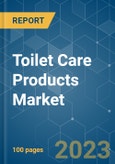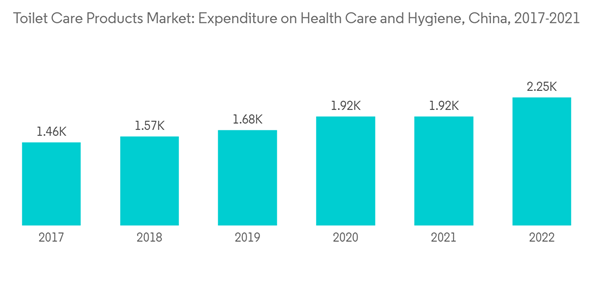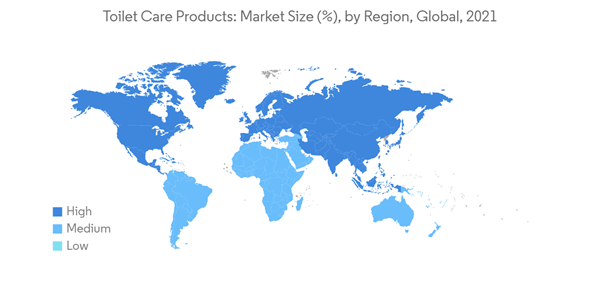The COVID-19 crisis significantly affected the toilet care products market. Consumers shifted their interest toward maintaining clean homes, washrooms, and other areas. This behavior was majorly due to the rising consciousness toward the necessity of hygiene to reduce germs and infections. Consumers preferred e-commerce websites to purchase these household products due to the closures of retail stores, hypermarkets/supermarkets, etc.
The market is expanding because of the shifting customer perceptions toward hygiene products. Increased social media penetration has led to progressive conversations about hygiene products and health among consumers, enhancing their lives in positive ways. For instance, according to the World Economic Forum, the percentage of US adults using at least one social media site in 2021 was 72%. The market for toilet care products is also driven by the increasing prevalence of intimate hygiene programs, product premiumization, consumer spending power, urbanization, and improved middle-class lifestyles. For instance, an SDG 6 initiative under the Dettol Clean Naija campaign, Dettol (Reckitt Benckiser Group PLC) Nigeria, announced plans to start its 2021 Dettol School Hygiene Education Programme. The program aims to raise awareness, educate, and motivate primary school students to incorporate hygienic practices into their daily lives.
Toilet Care Products Market Trends
Adoption of a Healthier Lifestyle
The growing importance of a healthier lifestyle due to rising concerns among individuals about healthy and hygienic living and dust and dirt-free environment led to rising per capita spending on toilet care products. Due to this factor, vendors are introducing innovative toilet and surface cleaners in terms of packaging, product bundling, quality, pricing, and fragrance. Increasing demand for convenience and easy-to-use/apply toilet cleaning products has contributed to the evolution of new toilet care products. The fragrance has played a vital role in toilet cleaning products for the past few years. Consumers are increasingly looking for products that offer a pleasant odor, thus making vendors differentiate their products. With more individuals understanding how important it is to maintain toilet hygiene, the market for toilet care products is expanding.Additionally, millennials have increased monthly spending on personal care and hygiene products. According to the Bureau of Labor Statistics, in the United States (2021), each consumer spent about USD 385 a year on average for personal care services, which was higher than in 2020. According to the most recent information made available by AdEx India, a branch of TAM Media Research, the amount of television advertising for the personal care and hygiene sector increased by 16% in 2021 compared to 2019. According to the survey, the top three categories made up more than 50% of the television advertisements for the personal care and hygiene industry. With a nearly one-fourth share of the TV advertising volumes, Hindustan Unilever maintained its position as the biggest advertiser.
Asia-Pacific is the Fastest-growing Market
Asia-Pacific is the fastest-growing market. The rising health consciousness among consumers regarding the prevalence of harmful diseases that can be spread through uncleaned toilets led to the rising sales of toilet care products in the region. Consumers across the region prefer eco-friendly toilet care products with natural and refreshing fragrances. The rise in per capita spending on home goods (including personal care items) in developing countries like China can be attributed to people's growing knowledge of the benefits of leading a healthier lifestyle for a clean and hygienic lifestyle. According to the Ministry of Finance of the People's Republic of China, the total public spending on hygiene/personal care and healthcare in 2021 for China was estimated at CNY 1.92 trillion.India has a sizable population, making it a lucrative market for toilet care goods, and hygiene awareness has significantly increased in the country. In addition, governments of various countries are taking various initiatives for clean toilets, thus boosting the market’s sales during the forecast period. For instance, the Government of India runs the “Clean India, Green India” (Swachh Bharat) sanitation program and has built more than 80 million toilets. As individuals become increasingly aware of the risks associated with the chemicals used in intimate hygiene products, demand from consumers for organic components is rising. Because of this rising awareness, major players are developing innovative, more comfortable, and novel solutions. For instance, in 2020, Better India launched India’s first subscription kits in a range of non-toxic home cleaners, including toilet cleaners.
Toilet Care Products Industry Overview
The toilet care products market is highly competitive. The majority of the share is held by the leading players, including Procter & Gamble, Unilever, Church & Dwight, Reckitt Benckiser Group, and The Clorox Company. Key players are focusing on online distribution channels for online marketing and branding to expand their geographic reach and increase their customer base. The leading manufacturers in the toilet care products market are focusing on leveraging opportunities posed by emerging Asian-Pacific markets, like China and India, to expand their revenue base. The key brands are embarking on mergers and acquisitions, new product developments infused with the latest technology that has less effect on the surroundings, and innovative advertising campaigns to achieve consolidation.Additional Benefits:
- The market estimate (ME) sheet in Excel format
- 3 months of analyst support
This product will be delivered within 2 business days.
Table of Contents
Companies Mentioned (Partial List)
A selection of companies mentioned in this report includes, but is not limited to:
- Henkel AG & Co. KGaA
- S. C. Johnson & Son Inc.
- Unilever PLC
- Kao Cooperation
- The Clorox Company
- Procter & Gamble
- Reckitt Benckiser Group PLC
- Church & Dwight Inc.
- Better Life
- Dabur










